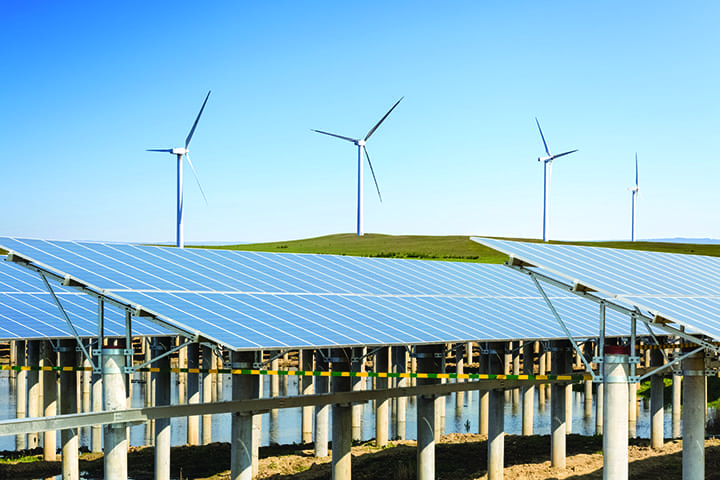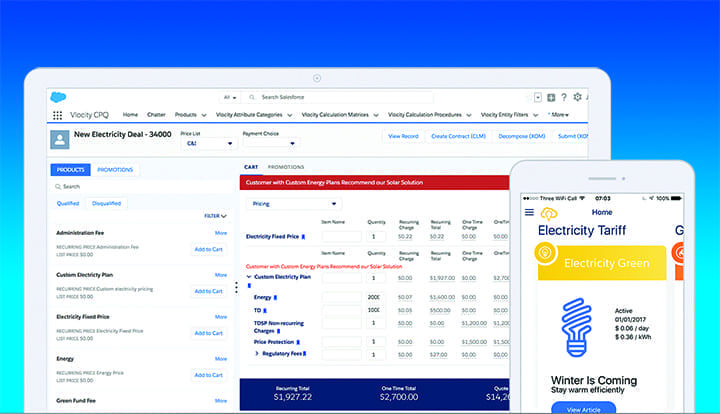Power customers are demanding personalized energy solutions, forcing the industry to alter business models. The leading providers of the future will be digital, agile, efficient, and highly customer-centric.
The digital transformation of the utilities industry is underway. In response to pressures on business models and customer demands for personalized energy solutions, the industry is shifting to new models centered on customer value, and digital customer and employee experiences. The COVID-19 pandemic has also drawn heightened attention to the need for a digital infrastructure that enables a remote workforce in the case of continued crisis and other disaster scenarios.
In fact, digital transformation is one of the highest priorities for utility companies, second only to the improvement of their top and bottom lines, according to recent research from HFS, a UK-based analyst firm specializing in the impact of digital technologies on enterprise business operations. More than 75% of companies surveyed plan to make a significant investment in digital workplace technologies this year in order to stay relevant with their customers and employees.
As important as going digital is a commitment to net-zero carbon emissions by 2050 to address growing climate change realities. In fact, most of the largest utility holding companies in the U.S. have announced plans to make deep cuts in their carbon emissions. This includes behemoth Duke Energy, which generates more electricity than any other U.S. company and last year announced its plan to get to net-zero carbon by 2050.
Combined with a move toward digital, companies that bake carbon reduction into their strategies will see significant business benefits, including increased innovation, competitiveness, risk management, and growth–according to Harvard Business Review journalist Nigel Topping. Even so, many utilities are waiting decades to make major changes rather than starting a more ambitious phaseout more quickly, drawing criticism from analysts and environmentalists. "Many of the companies are not doing this fast enough," said David Pomerantz, executive director of the Energy and Policy Institute.
Leading the Zero-Carbon Transition by Going Digital
French multinational ENGIE, however, is leading by example. The company is active in about 70 countries, employs more than 171,000 people worldwide, and achieved revenues of €60.1 billion last year. Amid rising concerns about climate change, in 2016, ENGIE committed to becoming the world leader in the transition to a zero-carbon future (Figure 1).
 |
|
1. ENGIE had 26.9 GW of renewable installed capacity at the end of 2019. Between 2019 and 2021, the group plans to build an additional 3 GW of renewable capacity per year. Courtesy: Vlocity |
As part of this transition, the company made the decision to shift from being a traditional utility company to a provider of low-carbon energy and services. ENGIE's goal is to bring consumers with them on this journey and develop the next generation of employees to deliver on its vision.
"ENGIE's ambition is to become the partner of the Fortune 500 and the 50 largest cities on planet earth in their zero-carbon agenda," said ENGIE Chief Digital Officer Yves Le Gélard.
ENGIE targeted three goals to achieve its ambition:
- ■ Reduce the carbon footprint of its own business worldwide and that of its customers by helping them reduce their energy needs. To supply the remaining energy needs of its customers, Engie would focus on providing green energy–decarbonized, decentralized, sustainable energy and energy services.
- ■ Build value for itself and its customers by delivering these energy services more efficiently and cost-effectively.
- ■ Foster growth among its customers and continuing success for itself by taking advantage of the new industries and innovations the shift to a decarbonized energy future will make possible.
But even as ENGIE reimagined the ways it engages with customers, like all utility companies, it was challenged by the limitations of legacy systems built for another era. In order to realize the future state it envisioned, ENGIE needed to digitally transform.
To do so, the company is working to replace a fragmented amalgamation of applications with a single solution offering a common, intelligent view of commercial and residential customers. This will allow ENGIE to put its customers at the center of its business, while empowering its employees to service customers with greater immediacy and transparency, transitioning together to a zero-carbon energy future.
With this view, ENGIE gains a 360-degree understanding of its customers, and the capability to provide personalized recommendations and collaborate with customers on defining new solutions. The company is able to proactively manage customer relationships by setting mutually agreed upon energy usage milestones, and automatically triggered alerts when nearing those thresholds, to reduce energy consumption over the next 50 years.
In France, a modern digital customer-facing technology solution now provides ENGIE customers with new self-service conveniences. In addition to improving customer service, these new omnichannel capabilities have created a number of important business efficiencies, including a significant decrease in the average number of calls and call duration for call centers. Agent productivity has soared and training time has been cut in half–a significant benefit, given ENGIE's need to train more than 2,000 agents on a new platform. Emmanuel Fouché, Chief Information Officer for ENGIE France, said the new platform "revolutionized ENGIE's customer engagement layer." These learnings and results contribute to the company's global customer strategy.
Finally, ENGIE's commitment to a zero-carbon future, enabled by an advanced technology infrastructure, is attracting a highly skilled workforce that will serve the company far into the future. "Truly motivated employees rally around their company's business model," said Le Gélard, who sees employee engagement as critical to customer success and is excited to find potential employees attracted to ENGIE's goals. "They are the human link between your company and your customers."
Digital Transformation Drives Business Efficiencies
British Gas, the largest energy and home services supplier in the UK, embarked on its journey to digital transformation and found that it not only improved customer relationships, but also increased efficiencies across the business. By adopting a modern, cloud-based technology solution, British Gas has lowered costs, streamlined business processes, and accelerated time to market for new offerings. In the process, the energy supplier significantly improved on a key pain point: quotes that previously took three days are now delivered in less than three minutes–an outcome much more in line with the high expectations of the company's business customers.
In addition, modern cloud solutions provide British Gas with crucial enterprise-grade security, scalability, performance, and availability–while also providing a robust and agile base for industry-specific applications, processes, and technologies. This allows information technology (IT) to move at the pace of business and move toward delivering unified, omnichannel customer experiences at a fraction of the price of custom-built or black box offerings. And it lays a future-proof foundation for agility, transformation, and disruptive innovation without the significant IT and business risks that come with custom solutions or major changes to legacy systems.
For British Gas, and the entire industry, the COVID-19 pandemic has shown the importance of being prepared for whatever the future holds and makes the flexibility of a cloud platform a business necessity.
Good News for Enabling Customer Strategies Industry-Wide
The power industry is well-positioned to forge new and better customer relationships thanks to three critical building blocks that already exist.
Trust. Despite oft-cited Accenture statistics about customers only spending nine to 11 minutes per year thinking about their utility, a recent survey by the Smart Energy Consumer Collective found that 78% of consumers in the U.S. trust their utility and are more likely to participate in a program or purchase a product if their utility endorses it.
Customer Knowledge. Utility companies are sitting on a treasure trove of customer data. It's a golden opportunity to gain greater customer insights, and tailor products and services to better satisfy customers. Other companies may have considerable data about business or residential customers' energy use too, but the utility is still the source of the commodity, usage data, and rates (Figure 2). They have the opportunity to use their advantage to benefit the customer, both directly and through strategic (and potentially revenue generating) partnerships.
 |
|
2. Vlocity's cloud and mobile software supports commercial and industrial pricing and quotation management through to order capture for utilities and retail energy service providers. Courtesy: Vlocity |
Agile Digital Technologies. Modern, cloud-based technologies are the key to providing 360-degree customer views, transparency into transactions, and the means for creating relationships that will allow for greater customer choice in a value-driven, multi-dimensional energy market. Digital operations are already driving new investment in data-driven technologies, such as artificial intelligence, machine learning, IoT sensors, and agile approaches to improving operational and maintenance efficiencies. All of which, in turn, will continue to reinforce the shift to the new partnership between energy companies and their customers.
An Opportunity to Build Lifetime Customer Value
ENGIE operates in competitive and newly deregulated energy markets across the European Union (EU)–markets that by design and by necessity are now driving investments in digitalizing both customer and infrastructure operations. Utilities, particularly in the U.S., where deregulation lags behind the EU, are learning that even though they have a mostly captive customer base, their customers are starting to demand a new relationship and a level of individual personalization that they are used to receiving as consumers. So, the need to support digital transformation is just as important–even if it is more challenging due to the sheer size of the customer base and the need to serve all segments of their individual markets.
The bottom line, however, is that the short-term pain is certainly worth the long-term gain for customers and the industry. The modern digital ecosystems being created will increase transparency and improve performance for utility customers. This will ensure that they will remain loyal and engaged. In turn, empowered customers will inspire new business models as utility companies learn to quickly adapt to the changing digital energy landscape.
The future for the utilities and power industry will be shaped by those who digitalize first and best. Power companies have a window of opportunity to seize the lead and shape this digital energy future. ■
–Kelly James is vice president and general manager for Vlocity Energy & Utilities (kjames@vlocity.com).
